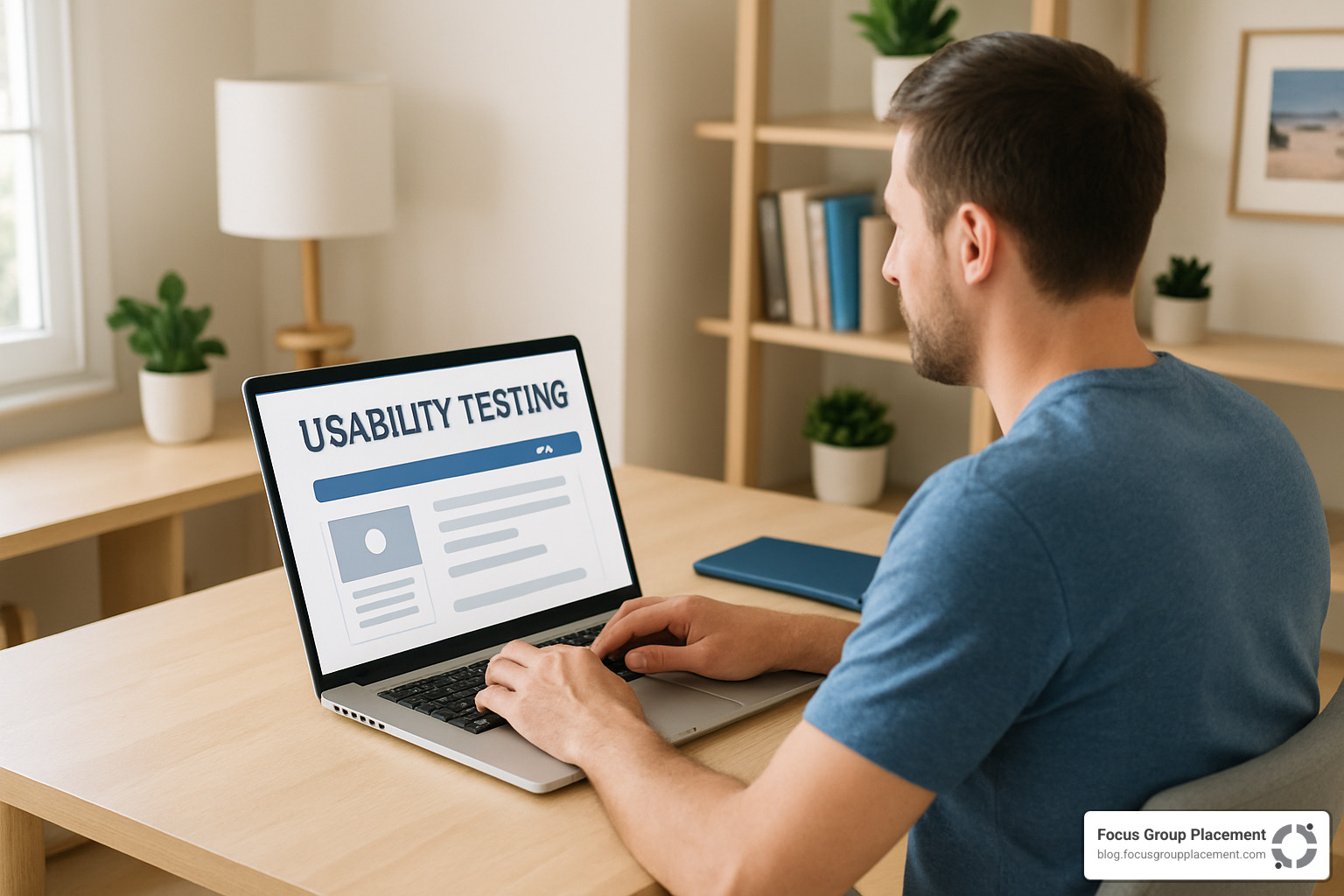Why Remote Product Testing Jobs Are Booming Right Now
Product testing remote jobs are legitimate opportunities where companies pay you to test their products from home and share your honest feedback. With over 2,000 work-from-home product tester positions currently available in the United States and 4,100+ remote roles in Canada, this field has exploded as brands realize they need real-world feedback from actual users.
Quick Overview of Remote Product Testing Jobs:
- Pay Range: $25-$45 per hour with weekly payments
- Time Commitment: 15-25 hours per week, flexible schedule
- Requirements: Age 18+, reliable internet, attention to detail
- Perks: Keep most products you test, work from anywhere
- No Experience Needed: Companies provide training and clear instructions
The process is straightforward: companies ship products to your home, you use them in your daily routine, then document your experience through photos, videos, and written feedback. You’re essentially getting paid to be a real customer and help brands improve their products before they hit the market.
Unlike traditional focus groups that require you to travel to a facility, remote product testing lets you work entirely from home. You might test anything from beauty products and electronics to household items and wearable technology. The best part? Most companies let you keep the products after testing.
I’m Scott Brown, founder of Focus Group Placement, and I’ve been connecting people with legitimate market research opportunities since 2014, including product testing remote jobs that offer real income potential. Through my work managing online survey communities, I’ve seen how remote testing has become one of the most accessible ways to earn extra income from home.

Product testing remote jobs vocab explained:
Product Testing Remote Jobs 101
If you’ve ever wondered what it’s like to get paid for your opinion, product testing remote jobs are exactly that – and so much more. As a remote product tester, you become a professional feedback provider, helping companies understand how their products perform when real people use them in real homes.
Your day-to-day responsibilities are surprisingly varied and engaging. You’ll follow detailed usage schedules (think “use this face cream twice daily for two weeks”), document your experience through photos, videos, and written feedback, and share honest opinions about everything from how easy a product is to use to whether the packaging makes sense.
Companies rely on this feedback to make smart marketing decisions, avoid embarrassing product flaws, and improve their offerings before they hit store shelves. You’re essentially their reality check – the voice of the actual customer they desperately need to hear.
What makes remote testing special is the flexibility it offers. Unlike traditional quality assurance jobs that chain you to a lab bench, product testing remote jobs let you test products in your actual living space. This gives companies incredibly valuable insights into how their products perform in messy, real-world conditions – not sterile testing environments.
Most remote testing follows what’s called “In-Home Usage Testing.” Here’s how it works: a package arrives at your door, you use the product according to specific instructions for anywhere from one to four weeks, then provide detailed feedback. The company covers shipping both ways, and here’s the best part – you typically keep the product afterward. It’s like getting paid to receive surprise gifts.
The schedule flexibility is genuine. You choose projects that fit your lifestyle, work around your existing commitments, and test products during times that make sense for your routine. And yes, these opportunities are completely legal – you’re providing a legitimate service that companies desperately need.
Types of testing you could do
The variety of products landing on testers’ doorsteps is genuinely exciting. Consumer goods testing might involve trying new snack foods, testing household cleaners, or evaluating personal care items. You’ll document practical details like taste, effectiveness, and whether you’d actually buy the product yourself.
Electronics testing focuses more on user experience than technical troubleshooting. You might test smartphone cases, smart home gadgets, or fitness trackers. I recently heard about a smartwatch study where participants simply wore the device for two weeks and shared feedback on comfort and daily usability – they earned $250 for what felt like normal life with a new gadget.
Software testing in the remote world typically means evaluating user experience rather than hunting for bugs. You’ll test mobile apps, websites, or software interfaces to see how intuitive they feel to regular users like yourself. No coding knowledge required – just your honest reaction to how things work.
Beauty product testing remains incredibly popular, with companies shipping everything from skincare routines to makeup collections. These studies often pay well because beauty companies know that genuine user feedback is worth its weight in gold.
Wearable technology testing has exploded recently, with companies needing real-world feedback on how devices perform during actual daily activities. These studies often offer higher pay because they require longer commitment periods and more detailed usage tracking.
Difference between product testing and quality assurance
Understanding this distinction will help you find the right opportunities and set proper expectations. Traditional quality assurance (QA) testing is all about finding bugs, glitches, and technical problems. QA testers need technical skills and typically work in controlled lab environments, methodically breaking things to see what goes wrong.
Remote product testing takes a completely different approach. You’re focused on end-user feedback and real-world usability. Instead of hunting for technical flaws, you’re evaluating whether the product actually works well for regular people going about their normal lives.
This lab-versus-home distinction is crucial. Companies specifically want your feedback from your actual living environment because that’s where their customers will use these products. Your messy kitchen counter, your poorly lit bathroom, your distracting living room – these real conditions often reveal insights that sterile lab testing completely misses.
That’s why no technical experience is required for most product testing remote jobs. Companies want authentic reactions from real people, not technical analysis from experts. Your value lies in being genuinely representative of their target customers.
Getting Hired: Skills, Applications & Legit Platforms
Here’s some great news about product testing remote jobs: you don’t need a college degree or years of experience to get started. Companies are actually looking for regular people who can follow directions carefully and share honest opinions about their products.
The basic requirements are pretty straightforward. You need to be at least 18 years old, have reliable internet access, and own a smartphone or digital camera for taking photos. Most importantly, you need strong attention to detail because companies rely on your feedback to make important decisions about their products.
Most product testing remote jobs treat you as an independent contractor, which means you’ll get 1099 tax forms at the end of the year instead of regular employee paperwork. Don’t worry – this is completely normal in the market research world.
Your computer skills don’t need to be fancy, but you should feel comfortable filling out online surveys and uploading photos or videos. Good communication skills matter too, since you’ll be writing detailed feedback and sometimes chatting with other testers online about your experiences.

The hiring process usually starts with demographic questions that might seem nosy, but there’s a good reason for them. Companies need specific types of people for different products. They might need parents for toy testing, dog owners for pet products, or people in their 60s for arthritis pain relief creams. Being honest in these screeners is crucial because lying can get you kicked out of programs permanently.
Your equipment needs are pretty minimal. A reliable computer or tablet, stable internet, and a camera that takes clear photos will cover most studies. Some projects ask for video recordings, so make sure your device can handle basic video and uploading.
When it comes to your resume or profile, emphasize your reliability and attention to detail. If you’ve ever written detailed online reviews, participated in surveys, or given customer feedback, mention those experiences. They show companies you can provide the kind of useful feedback they’re looking for.
For more insights into the broader world of market research, check out our guide on Online Research Studies.
Finding legitimate product testing remote jobs
The trick to finding real product testing remote jobs is knowing where to look and how to spot the genuine opportunities from the scams. Established market research companies and consumer panels are your safest bet because they have long-standing relationships with major brands and follow strict safety protocols.
Job boards like LinkedIn show thousands of product testing positions, but you need to be picky. Look for postings from companies with professional websites, clear contact information, and detailed job descriptions. The legitimate companies take their time to explain what you’ll be doing and what they expect from you.
Here’s what should make you run the other way: promises of guaranteed income, requests for your banking information before you’re even selected for a study, or companies that seem desperate to sign you up without proper screening. Real market research takes time, and legitimate companies are selective about who they work with.
Another red flag is any company asking you to pay upfront fees or purchase products before testing them. Legitimate product testing companies ship products to you for free and pay you for your time – never the other way around.
We recommend signing in for job alerts on professional job sites to stay updated when new opportunities become available.
Tips to land product testing remote jobs
Getting selected for product testing remote jobs comes down to presenting yourself as someone companies can count on. Start by creating complete, accurate profiles on market research platforms. The more detailed information you provide about yourself, the better companies can match you with studies that fit your lifestyle and interests.
Apply early when you see studies that interest you. Popular product categories like electronics, beauty products, and household items fill up fast. When you spot a study you qualify for, complete that application the same day if possible.
If you’ve done any product testing or market research before, share specific examples of the feedback you provided. Even detailed online reviews you’ve written for products you bought show companies you know how to give useful feedback that helps other people make decisions.
The biggest factor in getting more opportunities is proving your reliability. Respond to emails promptly, meet all deadlines, and follow instructions exactly as written. Companies keep detailed notes on how participants perform, and reliable testers get invited to the best-paying studies first.
The market research industry is smaller and more connected than you might think. Word gets around about who’s dependable and who isn’t. Build a good reputation early, and you’ll find yourself with a steady stream of interesting products to test and extra income to enjoy.
Pay, Perks & Typical Workflow
Let’s talk money – because that’s probably what you’re most curious about when it comes to product testing remote jobs. The pay is genuinely competitive, with most positions offering $25-$45 per hour. What makes this even better is that companies typically process payments weekly, so you’re not waiting around for a monthly paycheck.
Here’s something that might surprise you: the national average total compensation for product testers hits $50,821 annually. With about 15 years of experience under your belt, that number can climb to approximately $69,942. Not too shabby for testing products from your couch, right?
Most product testing remote jobs ask for a 15-25 hour weekly commitment, though this really depends on what you’re testing and how complex the study is. Some studies might only need a few hours spread across several weeks – like trying a new shampoo and rating how your hair feels. Others might require more intensive daily documentation, especially for tech products or fitness equipment.
The flexibility is one of the biggest draws. You can usually choose which studies to participate in based on your schedule and interests. Busy week at your day job? Skip the intensive studies and stick to simple product trials.
Since you’ll be working as an independent contractor, you’ll need to track your earnings for tax purposes. Companies send 1099 forms for earnings over $600 per year. It’s worth keeping a simple spreadsheet of your testing income – trust me on this one when tax season rolls around.
Now here’s the part that makes people’s eyes light up: you typically keep everything you test. Over a year, this can add serious value beyond your hourly earnings. I’ve seen testers accumulate hundreds of dollars worth of products – everything from the latest electronics to premium beauty items to useful household goods. It’s like getting paid to go shopping, except the products come to you.
The workflow from invitation to payment follows a pretty predictable pattern that makes planning easy. You receive an invitation based on your profile, complete a screening survey to make sure you’re the right fit, get selected and receive your product shipment, follow the usage schedule while documenting everything, submit your final feedback, and receive payment within 1-2 weeks. Simple and straightforward.

A day in the life of a remote tester
So what does a typical day actually look like when you’re doing product testing remote jobs? It starts with checking your usage schedule – most studies provide detailed daily instructions that are surprisingly specific. For example, “Use the skincare product on your face each morning, take a photo of your skin condition, and rate how it feels on a scale of 1-10.”
Documentation is where you’ll spend most of your time, but it’s more interesting than it sounds. You might photograph the product packaging when it first arrives (companies love seeing if their packaging survives shipping). You’ll take before and after photos showing product effects, especially for beauty or health products.
Recording short videos demonstrating how you use the product is becoming more common – and these often pay the highest rates because video feedback is so valuable to companies. You might also write journal entries about your daily experience, noting things like “Day 3: The lotion absorbed quickly but left my hands feeling slightly sticky.”
Companies usually provide specific formats for feedback, which takes the guesswork out of what they want. No need to stress about whether you’re doing it right – they’ll tell you exactly what they need.

Many studies include online chat discussions where you interact with other testers and research moderators. These conversations are actually pretty fun – you get to discuss what you liked, what could be improved, or how the product compares to similar items you’ve used. It’s like having a conversation with friends about products, except you’re getting paid for your opinions.
The time commitment varies significantly depending on what you’re testing. Testing a new snack might require just a few minutes daily to rate taste and document your experience. Testing a fitness tracker might mean wearing it for two weeks and providing weekly reports on accuracy and comfort.
Most testers find the work genuinely engaging because you’re trying new products before they hit the market, and your opinions directly influence product development. There’s something satisfying about knowing your feedback helped improve a product that thousands of other people will eventually use.
Safety, Scams & FAQs about Product Testing Remote Jobs
While legitimate product testing remote jobs are safe and profitable, the industry attracts scammers who prey on people seeking work-from-home opportunities. Understanding how to protect yourself is crucial for success in this field.
The most common scam involves upfront fees. Legitimate product testing companies never charge participants. If someone asks you to pay for a “starter kit,” “training materials,” or “processing fees,” it’s a scam. Real companies ship products to you at their expense and pay you for your feedback.
Fake check scams are another red flag. Scammers might send you a check for more than your agreed payment, then ask you to deposit it and send back the difference. These checks are fraudulent and will bounce, leaving you responsible for the full amount. Legitimate companies use direct deposit, PayPal, or prepaid cards for payment.

Protect your privacy by never sharing unnecessary personal information. While legitimate companies need your address for shipping and basic demographics for matching, they shouldn’t ask for social security numbers, bank account details, or other sensitive information until you’re officially selected for a paid study.
Always review contracts carefully before agreeing to participate. Legitimate agreements outline your responsibilities, payment terms, confidentiality requirements, and what happens to the products after testing. Be wary of contracts with excessive confidentiality clauses or unclear payment terms.
For more information about safe online research participation, check out our guide on Online Focus Groups That Pay.
Frequently Asked Questions about product testing remote jobs
Are product testing remote jobs legitimate and safe?
Yes, product testing remote jobs from established companies are legitimate and safe. The key is working with reputable market research firms that have proper business licenses, clear contact information, and positive reviews from previous participants. Look for companies with Better Business Bureau ratings and established track records in the market research industry.
Legitimate companies follow strict protocols for participant safety, including secure shipping procedures, clear contracts, and reliable payment systems. They also maintain confidentiality agreements to protect both your personal information and their proprietary product information.
To verify legitimacy, research the company online, look for professional websites with clear contact information, and check for reviews from other participants. Avoid companies that make unrealistic income promises or pressure you to sign up immediately without proper screening.
How flexible are the hours?
Product testing remote jobs offer excellent flexibility since you typically choose which studies to participate in based on your available time and interests. Most studies provide usage schedules rather than fixed working hours, allowing you to integrate testing into your daily routine.
You might test a skincare product by using it during your normal morning routine, or evaluate a mobile app during your commute. The key is following the study requirements consistently, but you usually have freedom in when you complete the daily tasks.
Many testers treat this as part-time work, participating in 2-3 studies simultaneously to maximize earnings while maintaining flexibility. Since studies have different time requirements and durations, you can select opportunities that fit your schedule.
Can beginners apply without experience?
Absolutely! Most product testing remote jobs welcome beginners and provide all necessary training and instructions. The main requirement is being at least 18 years old with reliable internet access and attention to detail.
Companies prefer fresh perspectives from people who haven’t been influenced by extensive product testing experience. Your honest, unbiased feedback as a regular consumer is exactly what they’re seeking. Many successful testers started with zero experience and learned through their first few studies.
Entry-level training typically includes detailed instructions for each study, examples of good feedback, and technical support for uploading photos or completing surveys. The learning curve is gentle, and most people feel comfortable after their first study.
Conclusion
If you’ve been searching for a legitimate way to earn money from home, product testing remote jobs offer exactly what you’re looking for. With hourly rates of $25-$45 and the chance to keep most products you test, it’s like getting paid to shop – except the products come to you, and you’re helping shape what millions of consumers will buy in the future.
The numbers speak for themselves: over 2,000 positions available in the US and 4,100+ in Canada means there’s real opportunity here. This isn’t some get-rich-quick scheme or too-good-to-be-true offer. It’s actual work that companies desperately need done, and they’re willing to pay well for honest feedback from real people like you.
What makes remote product testing so appealing is how it fits into your life rather than taking it over. You can test skincare products during your morning routine, evaluate a fitness tracker while going about your regular exercise, or try new household items as part of your normal cleaning schedule. The flexibility means you’re never scrambling to meet impossible deadlines or rearranging your entire life around work.
At Focus Group Placement, we’ve been connecting people with legitimate market research opportunities since 2014. We’ve seen how product testing remote jobs can provide steady part-time income for stay-at-home parents, supplement retirement income, or even help college students pay for expenses. The key is finding the right opportunities and avoiding the scams that unfortunately exist in this space.
Our platform takes the guesswork out of finding legitimate studies. Instead of spending hours searching job boards and wondering which companies are trustworthy, we connect you directly with established research companies that follow proper protocols and actually pay what they promise. We handle the vetting process so you can focus on what you do best – providing honest, detailed feedback about products.
Getting started is refreshingly simple. Create your profile with us, complete our demographic screening questions (this helps us match you with relevant studies), and you’ll start receiving invitations for product testing remote jobs that actually fit your lifestyle and interests. No complicated applications, no upfront fees, no mysterious requirements.
The beauty of this work is that it grows with you. Start with one study to see how you like it, then gradually take on more as you get comfortable with the process. Many of our successful testers began with zero experience and now earn several hundred dollars monthly while building an impressive collection of products they got to keep.
Ready to turn your opinions into income? Sign up with Focus Group Placement today and start exploring paid market research. Your feedback matters more than you realize, and companies are eager to pay for it. Let us help you find the right opportunities to start earning from home while helping create the products of tomorrow.
For a complete guide to getting started in paid research, check out How to Participate in Paid Focus Groups – it covers everything you need to know about maximizing your earning potential in the market research world.
















